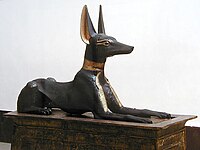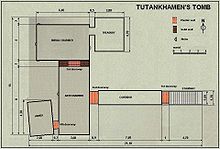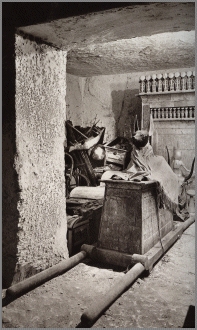Anubis Shrine
| Anubis Shrine | |
|---|---|
 The wood, plaster, lacquer, and gold leaf Anubis Shrine | |
| Size | 118 cm high, 270 cm long, 52 cm wide |
| Created | Reign of Tutankhamun, 18th Dynasty, New Kingdom |
| Discovered | Tomb of Tutankhamun: KV62, Valley of the Kings |
| Present location | Egyptian Museum, Cairo |
| Identification | JE 61444 |

The Anubis Shrine was part of the grave goods of Tutankhamun (18th Dynasty, New Kingdom). The tomb was discovered almost intact on 4 November 1922 in the Valley of the Kings in west Thebes by Howard Carter. Today the object, with the find number 261, is an exhibit at the Egyptian Museum in Cairo, with the inventory number JE 61444.
Discovery
The Anubis Shrine was found behind the unwalled entrance which leads from the grave chamber (J) into the so-called "Store Room" (Ja). The shrine, with a figure of Anubis on top, was facing towards the west. Behind it was the Canopic chest with the Pharaoh's canopic jars inside. During the work in the grave chamber, the entrance to the Store Room was blocked with wooden boards, so that the clearance work in the grave chamber would not damage the objects in the Store Room. Investigating and clearing the Store Room began in the fifth excavation season (22 September 1926 – 3 May 1927) and Carter first described the Anubis Shrine in his excavation journal on 23 October 1926.

Anubis statue
The statue of the Anubis, depicted completely in animal form as a recumbent jackal, was attached to the roof of the shrine. The statue is made from wood, covered with black paint. The insides of the ears, the eyebrows, and the rims of the eyes, and the collar and the band knotted around the neck, are worked in gold leaf. The whites of the eyes are made from calcite and the pupils from obsidian. The claws are in silver, which was more valuable[citation needed] than gold in Ancient Egypt.
The Anubis statue was wrapped in a linen shirt which was from the seventh regnal year of the Pharaoh Akhenaten, according to ink hieroglyphs on it. Underneath it was a very fine linen gauze tied at the front of the neck.[1] A scarf was wound around the neck of the figure, with lotus and cornflowers woven into it, tied in a loop behind the head.
Between its front legs was an inscribed tablet with the name of Akhenaten's eldest daughter, Meritaten.
The statue of Anubis was separated from the roof of the shrine on 25 October 1926 so that it could be transported through the grave chamber unscathed, out of the tomb and to the laboratory the next day, together with the shrine on the palanquin.
An Anubis statue found in the tomb of the Pharaoh Horemheb (KV57) is similar, except that its insets are made with gemstones.[2]
Shrine
The shrine is trapezoidal. In his records, Howard Carter called it a pylon after the structures found in front of the great temples at Karnak and Philae, which it resembles in shape. Like the jackal, the shrine is also made of wood, with a layer of plaster covered with gold leaf. The upper decoration shows the so-called djed pillar, a symbol of endurance which is linked closely with the god Osiris and the tyet, which can stand for life, like the ankh, and is a symbol of the goddess Isis. Inscriptions run horizontally along the upper edge and vertically along the sides on all faces of the shrine. There are no inscriptions on the base. The inscriptions invoke two manifestations of Anubis: Imiut (Jmj wt – "He who is in his wrappings") and Khenti-Seh-netjer (Ḫntj-sḥ-nṯr – "The first of the god's hall").[3] Inside the shrine are four small trays and a large compartment. These contain a range of jewelry, amulets and everyday objects, whose function is not entirely clear.
Function and significance

The shrine was placed on a palanquin, which had two carrying poles projecting from the front and back. It is therefore presumed that the Anubis shrine was used in the funerary procession of the Pharaoh and finally placed in front of the canopic chest in the Store Room. This and the orientation of the Anubis statue and shrine towards the west, the direction of the afterlife in Ancient Egyptian belief, show the role of the god Anubis as guardian of the Theban necropolis. This is made clear by a small brick of unfired clay, known as a magic brick, found at the entrance to the Store Room, in front of the shrine. This was the fifth magic brick found in Tutankhamun's tomb (usually there are only four, orientated to the cardinal points).
According to Carter, the brick was placed at the entrance to the Store Room for a reason, since the brick had a magic formula upon it, intended to protect the deceased: "It is I who hinder the sand from choking the secret chamber, and who repel that one who would repel him with the desert flame. I have set aflame the desert (?), I have caused the path to be mistaken. I am for the protection of the deceased."[4]
The inscription on this brick was the origin of the Curse of the pharaohs,[5] which was propagated in the international press of the time in many different versions rather than this original translation.
The statue of the jackal lying on the shrine is in the same posture and form as one hieroglyph (Gardiner list: E16) for the god Anubis. However, this hieroglyph also signifies the title jnpw ḥrj-sštȝ ("Anubis over the mysteries"), apparently with a double meaning: watcher and master of mysteries.[6]
Bibliography
- Die Hauptwerke im Ägyptischen Museum in Kairo. Offizieller Katalog. Publication of the heritage service of Egypt. Von Zabern, Mainz 1986, ISBN 3-8053-0640-7, No. 185.
- Howard Carter. Das Grab des Tut-ench-Amun. Brockhaus, Wiesbaden 1981, V. No. 1513, ISBN 3-7653-0262-7, p. 170.
- Zahi Hawass. Anubis Shrine. (= King Tutankhamun. The Treasures Of The Tomb.) Thames & Hudson, London 2007, ISBN 978-0-500-05151-1, pp. 158–159.
- T. G. H. James:. Tutanchamun. Müller, Köln 2000, ISBN 88-8095-545-4, pp. 156–157.
- M. V. Seton-Williams: Tutanchamun. Der Pharao. Das Grab. Der Goldschatz. Ebeling, Luxembourg 1980, ISBN 3-8105-1706-2, pp. 37, 95.
References
- ^ Howard Carter, Das Grab des Tut-ench-Amun. p. 170.
- ^ Theban Mapping Project: KV57, Wooden statue of Anubis jackal (Ref.: 12656)
- ^ Rolf Felde, Ägyptische Gottheiten. 2nd edition. R. Felde Eigenverlag, Wiesbaden 1995, p. 6.
- ^ Excavation journal of Howard Carter, 29. October 1926
- ^ Zahi Hawass: Anubis Shrine. (= King Tutankhamun. The Treasures Of The Tomb.), p. 158.
- ^ I. E. S. Edwards, Tutanchamun. Das Grab und seine Schätze. Lübbe, Bergisch Gladbach 1997, ISBN 3-7857-0876-9, p. 153.

